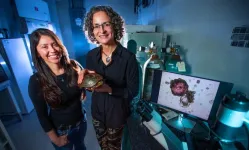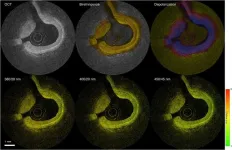(Press-News.org) There are plenty of reasons to worry about the quality of contemporary Canadian journalism, beyond shrinking newsrooms and attention spans.
Once considered a vital pillar of a healthy democracy, the country’s biggest newspapers have been embracing the type of content critics refer to as “infotainment,” which uses entertainment-style methods to communicate politically relevant information.
In a new paper published in the Canadian Journal of Political Science, PhD candidate Robert Marinov examines, measures and evaluates the scope and nature of infotainment in Canada’s largest newspapers. Using the 2019 federal election as a case study, Marinov analyzed news stories from the Globe and Mail, Toronto Star, the National Post, Montreal Gazette, Calgary Herald and the Vancouver Sun. Given the high volume of duplicated articles between the latter four Postmedia newspapers, they were grouped together for the purposes of analysis.
Marinov collected 969 distinct hard news items over the campaign’s 41 days. Using a mixed-methods mode of discourse analysis, he assigned them a score of one to five, one being predominantly informative and five being predominantly entertaining.
He found that 51 per cent — more than half — of all hard news articles showed clear evidence of substantial infotainment traits (rating three to five), and 42 per cent demonstrated strong to very strong infotainment characteristics (four or five).
On the other end, almost 49 per cent of the articles in the dataset showed no (rating one on five) or few (two on five) entertainment characteristics.
Articles with significant infotainment characteristics (four to five rating) comprised 52 per cent of Postmedia hard news items. That number drops to 39 per cent for the Toronto Star and 35 per cent for the Globe and Mail.
“There is a fair amount of research that shows more conservative or right-wing political narratives tend to engage in more emotional discourses compared to more left-wing discourses, which tend to be more rationalist,” Marinov says. “We did hypothesize that these ideological differences might contribute to some of the results we found in Postmedia, which is typically more right-leaning than the Globe and Mail or Toronto Star. But it is hard to quantify by how much or to confirm this without further research.”
Still ‘a strong amount’ of analytical and investigative coverage
Marinov synthesized previous literature on infotainment to create a comprehensive framework that could stand up to robust investigation. Three categories emerged.
The first was personalization. This entails a focus on politicians and their personal characteristics, their private lives, their appearances, their manners of speaking, their behaviour and actions during an election campaign.
The second is sensationalization. This focuses on gaffes, scandals, the sensational framing of topics and emotionally driven narratives.
Both combine to serve the third category, decontextualization, where the focus is on speculation and strategic game-framing — who is ahead in the latest poll, who scored points on the campaign trail, who performed a good trick or stunt — without any focus on actual policy options.
Despite the large volume of infotainment found in mainstream Canadian newspapers’ political coverage, Marinov says he is still somewhat relieved that it is not any higher.
“It is promising to see that there is still quite a strong amount of coverage that adopts an analytical or investigative tone, that presents more concrete, substantive information about policy options and debates,” he says. “But the numbers also show that the infotainment approach has a lot of purchase in Canadian newspaper coverage. This can have important impacts on how voters are being informed during an election.”
Paul Saurette of the University of Ottawa co-authored the study.
This article drew on research supported by the Social Sciences and Humanities Research Council of Canada (SSHRC).
Read the cited paper: “Infotaining Canadian Politics? Measuring Infotainment in English-Language Newspaper Coverage of the 2019 Canadian Federal Election
END
Infotainment is coming for your news, warns Concordia Ph.D. student Robert Marinov
Personal foibles and horse races competed with substantive coverage and discourse during the 2019 federal election, according to a new analysis of Canadian newspaper coverage
2024-03-05
ELSE PRESS RELEASES FROM THIS DATE:
Lab-grown liver organoid to speed up turtle research, making useful traits easier to harness
2024-03-05
AMES, Iowa – At a Biotechnology Council event a few years ago, Nicole Valenzuela’s ears perked up when she heard what a group of researchers in Iowa State University’s College of Veterinary Medicine had in the works: a method for creating a lab-grown, simplified mimic of dog intestines.
“I told them, ‘Oh! I want to do that but with turtles. Is it doable?” said Nicole Valenzuela, professor of ecology, evolution and organismal biology at Iowa State.
It is indeed doable, new research from a team led by Valenzuela shows. The three-dimensional clusters ...
Patients with Parkinson’s disease who experience freezing of gait have sleep disorders, study shows
2024-03-05
Parkinson’s disease patients who experience freezing of gait (a sudden inability to initiate or continue movement, often resulting in a fall) wake up several times during the night, feel sleepy during the day, and have REM sleep behavior disorder. Rapid eye movement (REM) sleep plays a role in the maintenance of many cognitive processes.
These are key findings of a study supported by FAPESP and conducted by researchers at São Paulo State University (UNESP) in Brazil and Grenoble Alps University (UGA) in France. An article on the study is published in ...
Study finds no safety concerns when the dapivirine vaginal ring is used during the second and third trimesters of pregnancy, according to results presented at CROI 2024
2024-03-05
PITTSBURGH, March 5, 2024 -- Results of the third and final cohort of the DELIVER (MTN-042) Phase IIIb study found no safety concerns with use of the monthly dapivirine vaginal ring beginning during the second trimester of pregnancy and up to the time of delivery, researchers reported today at the Conference on Retroviruses and Opportunistic Infections (CROI 2024) in Denver. With this latest data, the researchers believe there is now sufficient evidence that the dapivirine ring is safe to use ...
After decades of Arctic sea ice getting faster and more hazardous for transport, models suggest a dramatic reversal is coming, York University study finds
2024-03-05
TORONTO, March 5, 2024 – Will ice floating in the Arctic Ocean move faster or slower over the coming decades? The answer to this question will tell us whether marine transportation can be expected to get more or less hazardous. It might also have important implications for the rate of ice cover loss, which is hugely consequential for Northern Indigenous communities, ecosystems, and the global climate system.
While observational data suggest the trend has been towards faster sea ice speeds, ...
Pioneering work in computational and theoretical neuroscience is awarded the world’s largest brain research prize
2024-03-05
The Lundbeck Foundation has announced the recipients of The Brain Prize 2024, the world’s largest award for outstanding contributions to neuroscience. This year’s award recognizes the pioneering work of three leading neuroscientists – Professor Larry Abbott at Columbia University (USA), Professor Terrence Sejnowski at the Salk Institute (USA), and Professor Haim Sompolinsky at Harvard University (USA) and the Hebrew University (Israel).
Theoretical and computational neuroscience permeates neuroscience today ...
New cardiovascular imaging approach provides a better view of dangerous plaques
2024-03-05
WASHINGTON — Researchers have developed a new catheter-based device that combines two powerful optical techniques to image the dangerous plaques that can build up inside the arteries that supply blood to the heart. By providing new details about plaque, the device could help clinicians and researchers improve treatments for preventing heart attacks and strokes.
Atherosclerosis occurs when fats, cholesterol and other substances accumulate on the artery walls, which can cause these vessels to become thick ...
BU study finds robotic-assisted surgery for gallbladder cancer as effective as traditional surgery
2024-03-05
(Boston)—Each year, approximately 2,000 people die annually of gallbladder cancer (GBC) in the U.S., with only one in five cases diagnosed at an early stage. With GBC rated as the first biliary tract cancer and the 17th most deadly cancer worldwide, pressing attention for proper management of disease must be addressed. For patients diagnosed, surgery is the most promising curative treatment. While there has been increasing adoption of minimally invasive surgical techniques in gastrointestinal malignancies, including utilization of laparoscopic ...
We know the Arctic is warming -- What will changing river flows do to its environment?
2024-03-05
AMHERT, Mass.– Scientists at the University of Massachusetts Amherst recently combined satellite data, field observations and sophisticated numerical modeling to paint a picture of how 22.45 million square kilometers of the Arctic will change over the next 80 years. As expected, the overall region will be warmer and wetter, but the details—up to 25% more runoff, 30% more subsurface runoff and a progressively drier southern Arctic, provides one of the clearest views yet of how the landscape will respond to climate change. The results were published in the journal The Cryosphere.
The Arctic is defined ...
BU researcher examines clinicians’ attitudes towards major changes from the 2020 ACS Cervical Cancer Screening Guidelines
2024-03-05
(Boston)—Nearly all cervical cancers are caused by the human papillomavirus (HPV). New evidence has led to dramatic changes in cervical cancer screening recommendations over the past 20 years. In 2020, the American Cancer Society (ACS) released updated guidelines for cervical cancer screening. The main changes to current practices were to initiate screening at age 25 instead of age 21 and to screen using primary HPV testing rather than cytology (PAP test) alone or in combination with HPV testing. Since adoption of guidelines often occurs slowly, understanding clinician attitudes is important ...
The Arctic could become ‘ice-free’ within a decade
2024-03-05
The Arctic could see summer days with practically no sea ice as early as the next couple of years, according to a new study out of the University of Colorado Boulder.
The findings, published March 5 in the journal Nature Reviews Earth & Environment, suggest that the first ice-free day in the Arctic could occur over 10 years earlier than previous projections, which focused on when the region would be ice-free for a month or more. The trend remains consistent under all future emission scenarios.
By ...
LAST 30 PRESS RELEASES:
American College of Cardiology comments on new dietary guidelines for Americans
American Society of Gene & Cell Therapy and Orphan Therapeutics Accelerator partner to advance and commercialize promising rare disease treatments
One in 14 patients having day case surgery have new or worse chronic pain 3 months after their operation
New study highlights link between eviction rates and gun violence
Heatwaves heat up soil but not toxin levels in rice, study finds
Digital modeling reveals where construction carbon emissions really come from
Turning farm waste into water filters
New study shows how the spleen helps the immune system accept a transplant
New Mayo Clinic study advances personalized prostate cancer education with an EHR-integrated AI agent
Researchers identify novel therapeutic target to improve recovery after nerve injury
Microbes in breast milk help populate infant gut microbiomes
Reprogramming immunity to rewrite the story of Type 1 diabetes
New tool narrows the search for ideal material structures
Artificial saliva containing sugarcane protein helps protect the teeth of patients with head and neck cancer
Understanding the role of linear ubiquitination in T-tubule biogenesis
Researchers identify urban atmosphere as primary reservoir of microplastics
World’s oldest arrow poison – 60,000-year-old traces reveal early advanced hunting techniques
Bristol scientists discover early sponges were soft
New study uncovers how rice viruses manipulate plant defenses to protect insect vectors
NSF–DOE Vera C. Rubin Observatory spots record-breaking asteroid in pre-survey observations
Ribosomal engineering creates “super-probiotic” bacteria
This self-powered eye tracker harnesses energy from blinking and is as comfortable as everyday glasses
Adverse prenatal exposures linked to higher rates of mental health issues, brain changes in adolescents
Restoring mitochondria shows promise for treating chronic nerve pain
Nature study identifies a molecular switch that controls transitions between single-celled and multicellular forms
USU chemists' CRISPR discovery could lead to single diagnostic test for COVID, flu, RSV
Early hominins from Morocco reveal an African lineage near the root of Homo sapiens
Small chimps, big risks: What chimps show us about our own behavior
We finally know how the most common types of planets are created
Thirty-year risk of cardiovascular disease among healthy women according to clinical thresholds of lipoprotein(a)
[Press-News.org] Infotainment is coming for your news, warns Concordia Ph.D. student Robert MarinovPersonal foibles and horse races competed with substantive coverage and discourse during the 2019 federal election, according to a new analysis of Canadian newspaper coverage




